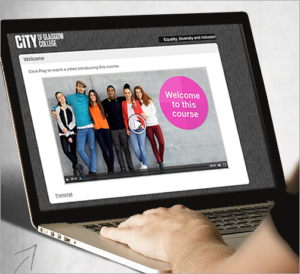Why Choose Diversity Training?
27th September 2013

In our latest “e-learning insights” post we look at the benefits and best practice of equality and diversity training.
Equality and diversity in the workplace have become increasingly important in recent years. While it would be nice to think that both of these aspects of working life would manage themselves in a modern-day environment, they sometimes require a bit of help. In many cases friction in the workplace is based much more on lack of understanding than on actual malice or prejudice.
 The business case
The business case
Whilst some employers may find themselves criticised for spending on diversity training, the business benefits are numerous. Not only does it protect the company from potential legal issues, but it’ s also a proven model for profitability, which can be up to 30% higher than if no diversity training is carried out.
The creation of diversity in teams depends on the creation of a culture within the workplace to foster a happy workforce. According to a Harvard study, those companies with diversity at the top table are more likely to be more attuned to their customer needs and tend to be more creative when it comes to product design.
The importance of branding
Many companies ignore the importance of branding their learning products. Employees that learn on a fully-branded platform with company logos and colours are much more likely to apply themselves.
This is because the branding illustrates, on a psychological level, the importance of equality and diversity training to the company, further reinforcing the company ethos when it comes to the issue.
Written, online (self-study), online (tutor-led) or face-to-face?
While self-study courses are the most cost-effective, they are also the most open to being ignored. Even courses with a written assessment can lead to staff simply learning enough to scrape through and ignoring the rest. Tutor-led courses are obviously more expensive, particularly if travel is involved. However, the sophistication of today’s LMS and online learning technology drastically reduces the need to book trainers and classrooms.
General or tailored?
 Equality and diversity is a wide-ranging topic and covers strands such as: gender, race and culture, religion and belief, sexual orientation, age and disability. These can be analysed still further, for example disability could cover common issues such as hearing impairments or speech impediments to more significant disabilities and physical or mental impairments.
Equality and diversity is a wide-ranging topic and covers strands such as: gender, race and culture, religion and belief, sexual orientation, age and disability. These can be analysed still further, for example disability could cover common issues such as hearing impairments or speech impediments to more significant disabilities and physical or mental impairments.
Giving full training on all aspects of a diversity strand can be a time-consuming and expensive process. With this in mind, it may be appropriate to limit full training to certain staff, for example HR and senior management and to focus training for other employees on topics which are more directly relevant to them or provide unconscious bias training, something that we will discuss in more detail next week.
Intended outcomes?
Obviously the general aim of all equality and diversity training is to promote equality and diversity in the workplace; however the specific outcomes of any course can vary:
- a deeper understanding of the relevant laws and their implications for the way companies do business
- a set of general guidelines on the principles of equality and diversity
- specific examples of how to promote equality and diversity in the workplace or
- a combination of all of the above.
Again, the aim(s) of any training session should reflect business needs. While HR staff will definitely need to be familiar with the details of the law, it may be enough for managers, even senior ones, just to know the general principles, along with the key points of law and a framework on taking action when required, including when to seek guidance from subject-matter experts. For those without direct line management, responsibilities may be better served by training based on the practicalities of gender and diversity in the workplace.
Follow on?
The old education axiom is salience + repetition = learning. In other words, it helps a lot to follow through on training courses to ensure that staff continue to apply their learning.
The first and most obvious point to check is that the company as a whole is walking the walk as well as talking the talk. In short, companies can send their employees on countless courses, but unless the principles of equality and diversity are both applied and seen to be applied in the organisation, it’s likely to be a waste of time and money.
 Secondly, it needs to be remembered that in an office environment, the need to re-enforce equality and diversity training is inevitably going to compete with a number of other demands, particularly an employee’s day-to-day work.
Secondly, it needs to be remembered that in an office environment, the need to re-enforce equality and diversity training is inevitably going to compete with a number of other demands, particularly an employee’s day-to-day work.
The lessons need to be bite sized and, ideally, genuinely relevant, they also need to be entertaining, interesting, motivating or contain engaging content perhaps through gamification. They don’t even need to be directly related to an individual’s job function or even the company, although it’s preferable if they are.
For example, news stories about Paralympians can re-enforce positive messages about working with people with disabilities. Running competitions is always a good way to get people’s attention and prizes don’t have to be big to be interesting. Occasional road-shows or public events help to bring a social aspect to learning.
Equality and diversity training can lead to a happy workforce that is content that not only do they feel protected from discrimination, but that they are working for a company with a good solid company ethos.
If you would like to find out more about our training courses please get in touch.

